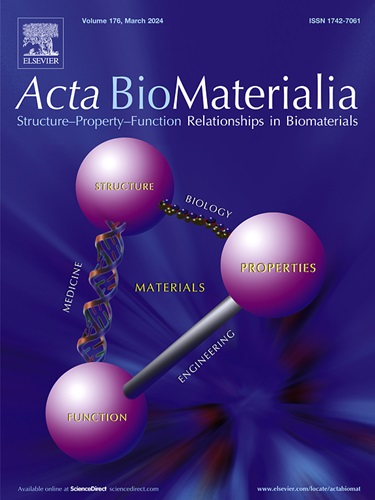2D MX2靶向自噬治疗肺部炎症(M = W, Nb;X = S, Se)纳米片。
IF 9.6
1区 医学
Q1 ENGINEERING, BIOMEDICAL
引用次数: 0
摘要
在生物医学应用中,二维过渡金属二硫族化合物(2D TMDCs)通常与其他元素结合或与特定的表面配体功能化,而其内在的生物活性尚未完全了解。本研究研究了四种未经修饰的二维TMDCs,包括WS2、WSe2、NbS2和NbSe2纳米片,在体外lps激活的MH-S细胞和体内肺部炎症小鼠模型中的抗炎潜力。尽管它们的成分不同,但这些2D TMDCs在lps激活的MH-S细胞中表现出相似的抗炎作用。值得注意的是,2D TMDC纳米片通过粘附细胞膜和/或被细胞内化来破坏自噬信号通路,从而增强细胞自噬,并通过抑制NFκB磷酸化来减少lps诱导的促炎反应。它们对肺组织的天然亲和力使这些2D TMDCs成为治疗肺部炎症的有希望的药物,lps诱导小鼠模型的结果进一步支持了这一发现。重要的是,这些结果强调了2D TMDCs在自噬信号传导中的关键作用,这可能显著推进肺部炎症个性化治疗的发展。意义声明:自噬是炎症性肺部疾病治疗干预的一个有希望的靶点。本研究探讨了各种原始二维过渡金属二硫族化合物(2D TMDCs)作为自噬的调节剂在肺部炎症的靶向治疗中的作用。它强调了组成在形成2D TMDCs对自噬信号传导的影响中的关键作用,从而促进了肺部炎症个性化治疗的发展。本文章由计算机程序翻译,如有差异,请以英文原文为准。

Autophagy-targeted therapy for pulmonary inflammation by 2D MX2 (M = W, Nb; X = S, Se) nanosheets
For biomedical applications, two-dimensional transition metal dichalcogenides (2D TMDCs) are often combined with other elements or functionalized with specific surface ligands, while their intrinsic biological activities are not yet fully understood. This study investigates the anti-inflammatory potential of four unmodified 2D TMDCs, including WS2, WSe2, NbS2, and NbSe2 nanosheets, in LPS-activated MH-S cells in vitro and in a mouse model of pulmonary inflammation in vivo. Despite their varying compositions, these 2D TMDCs exhibited comparable anti-inflammatory effects in LPS-activated MH-S cells. Notably, the 2D TMDC nanosheets disrupted autophagic signaling pathways by adhering to the cell membrane and/or being internalized by the cells, thereby enhancing cellular autophagy and reducing the LPS-induced pro-inflammatory response by inhibiting NFκB phosphorylation. Their natural affinity for lung tissue makes these 2D TMDCs promising therapeutic agents for pulmonary inflammation, a finding further supported by results from the LPS-induced mouse model. Importantly, these results highlight the critical role of composition in the effects of 2D TMDCs on autophagic signaling, which could significantly advance the development of personalized therapies for pulmonary inflammation.
Statement of significance
Autophagy represents a promising target for therapeutic intervention in inflammatory lung diseases. This study explores various pristine two-dimensional transition metal dichalcogenides (2D TMDCs) as regulators of autophagy for targeted therapy in pulmonary inflammation. It emphasizes the crucial role of composition in shaping the effects of 2D TMDCs on autophagic signaling, thereby advancing the development of personalized therapies for pulmonary inflammation.
求助全文
通过发布文献求助,成功后即可免费获取论文全文。
去求助
来源期刊

Acta Biomaterialia
工程技术-材料科学:生物材料
CiteScore
16.80
自引率
3.10%
发文量
776
审稿时长
30 days
期刊介绍:
Acta Biomaterialia is a monthly peer-reviewed scientific journal published by Elsevier. The journal was established in January 2005. The editor-in-chief is W.R. Wagner (University of Pittsburgh). The journal covers research in biomaterials science, including the interrelationship of biomaterial structure and function from macroscale to nanoscale. Topical coverage includes biomedical and biocompatible materials.
 求助内容:
求助内容: 应助结果提醒方式:
应助结果提醒方式:


